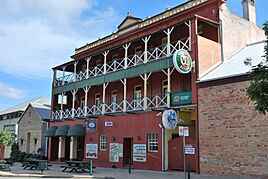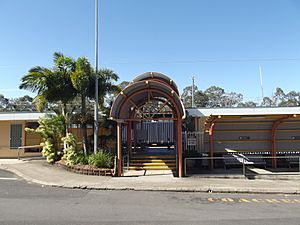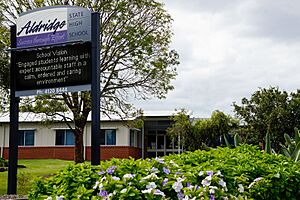Maryborough, Queensland facts for kids
Maryborough (pronounced MARE-ih-bər-ə) is a city and a suburb in the Fraser Coast Region, Queensland, Australia. In the 2021 census, the suburb of Maryborough had a population of 15,287 people. The wider urban area had 27,489 people.
Quick facts for kids MaryboroughQueensland |
|||||||||||||||
|---|---|---|---|---|---|---|---|---|---|---|---|---|---|---|---|
|
St Stephen's Uniting Church
Mortuary Chapel and cemetery
|
|||||||||||||||
| Population |
|
||||||||||||||
| • Density | 161.13/km2 (417.3/sq mi) | ||||||||||||||
| Established | 1847 | ||||||||||||||
| Postcode(s) | 4650 | ||||||||||||||
| Elevation | 11.0 m (36 ft) | ||||||||||||||
| Area | 170.6 km2 (65.9 sq mi)(Significant Urban Area) | ||||||||||||||
| Time zone | AEST (UTC+10) | ||||||||||||||
| Location |
|
||||||||||||||
| LGA(s) | Fraser Coast Region | ||||||||||||||
| State electorate(s) | Maryborough | ||||||||||||||
| Federal Division(s) | Wide Bay | ||||||||||||||
|
|||||||||||||||
|
|||||||||||||||
Contents
Geography
Maryborough is located on the Mary River in Queensland, Australia. It is about 255 kilometres (158 miles) north of Brisbane, the state capital. The city is connected by the Bruce Highway. It is also close to Hervey Bay, which is about 30 kilometres (19 miles) northeast. Together, these cities are part of the Fraser Coast area.
The neighborhood of Baddow is in the western part of Maryborough, near the Mary River. It gets its name from Baddow House, a historic building there. Baddow railway station and Baddow Island in the Mary River are also named after the house.
History
Early Inhabitants and Culture
People have lived in the Maryborough area for at least 6,000 years. The Gubbi Gubbi (Kabi Kabi) and Batjala (Butchulla) people were the first inhabitants. The Gubbi Gubbi lived inland, covering a large area west of Maryborough. Their lands reached Childers and Hervey Bay to the north, and the Mary River headwaters to the south. The Batjala lived closer to the coast, including K’gari (Fraser Island).
Both groups spoke dialects of the Dippil language. The Batjala dialect was used in the Fraser Coast region. The Gubbi Gubbi dialect was spoken in the Gympie and Sunshine Coast areas.
James Davis lived with several Gubbi Gubbi groups from 1829 to 1842. He became part of their community and was called Duramboi. In 1842, Andrew Petrie and Henry Stuart Russell explored the river the Gubbi called Monoboola, which is now the Mary River. They found Duramboi living with a Gubbi group near where Maryborough is today.
The Queensland lungfish was important to the Gubbi Gubbi people. They had a special rule against eating it. The Batjala people thought porpoises were very special.
European Settlement
British explorers Matthew Flinders (1802) and William Edwardson (1822) were the first Europeans to map the Hervey Bay coast. They noticed many local people living there.
After these explorations, settlers began to arrive, looking for land for sheep farms. Maryborough was founded in 1847 by George Furber, who set up a small wool storage area by the river. By 1849, a post office, court, and police station were open. The town was officially planned in 1850, and the first land was sold in 1852. The name Maryborough came from the Mary River, which was named in 1847 after Mary Lennox, the wife of the Governor of New South Wales.
Growth and Development
Maryborough became a municipality in 1861 and a city in 1905. In the late 1800s, it was a major port for immigrants coming to Queensland.
The first Catholic School opened by February 1858. Maryborough Central State School opened in 1862. It later split into separate schools for boys and girls, then combined again in 1932.
A Wesleyan Methodist Church opened in 1864. A new, larger brick church was built in 1883. This church later became part of the Uniting Church in Australia in 1977.
In July 1870, St Joseph's Catholic School was started by Mary MacKillop and her Sisters of St Joseph of the Sacred Heart. This school closed in 1879. In 1880, the Sisters of Mercy reopened the school as St Mary's School. St Mary's later added a secondary school for girls in 1928. In 1979, it combined with Sacred Heart College to form St Mary's Primary School and St Mary's College, offering education for both boys and girls.
St Paul's Anglican Church, Maryborough opened in 1879. Its bell tower was added in 1887.
Maryborough Boys Grammar opened in 1881, and Maryborough Girls Grammar opened around 1882. In 1936, the Queensland Department of Education took over these schools. They eventually combined to form Maryborough State High School in 1974.
The first part of the North Coast Line opened on August 6, 1881. It connected the mining town of Gympie to Maryborough. Coal was found at Burrum, north of Maryborough, and a railway line to serve the mine opened in 1883.
Albert State School opened on July 9, 1883. Newtown Maryborough State School opened in 1886 and was renamed Maryborough West State School. Sunbury State School opened in 1891.
The Christian Brothers started Sacred Heart College for older boys in 1888. This college closed in 1978 and joined with St Mary's School.
Maryborough experienced a serious health event in 1905. A ship from Hong Kong, where a disease was present, was in the Port of Maryborough. A worker took some sacking home, and several family members and nurses became ill and passed away. The family's house was later burned down by health officials. A memorial fountain was built at the City Hall for the nurses, Cecelia Bauer and Rose Wiles.
The Maryborough War Memorial was dedicated on November 19, 1922.
The Andronicus Brothers opened the Café Mimosa in the 1920s. It was a popular spot for events.
Maryborough Special School opened in 1969. Aldridge State High School opened in 1973, named after Edgar Thomas Aldridge, an early resident. The Maryborough Library opened in 1977.
In 2008, the Maryborough City Council became part of the Fraser Coast Regional Council.
Economy and Industry
Tourism is a big part of Maryborough's economy today. The city is known as the Heritage City of Queensland and has heritage markets every Thursday. Many old buildings from the 1800s and 1900s are still standing, like the General Post Office and Customs House.
A major industrial company here is Downer Rail, which used to be called Walkers Limited. This company builds trains and locomotives for Queensland Rail. They also built and tested trains for Perth's public transport system.
The Maryborough Sugar Factory opened in 1956. There were also many smaller sugar mills along the Mary River. Dundathu was an old settlement where the first timber mill was built in the 1800s.
Maryborough also earns money from farming and fishing. The city has a long history with the timber industry. Hyne & Son, one of Australia's largest timber producers, is based here.
Maryborough was once an important centre for railway and tramway operations.
Transport
Maryborough West station is on the North Coast line. Long-distance trains like the Spirit of Queensland and Spirit of the Outback stop here.
This station was built in the late 1980s as part of a new railway section. It replaced the old Maryborough station in the city centre. The old branch line is still used for train workshops.
Maryborough has coach services from Greyhound Australia and Premier Motor Services. These connect to cities like Brisbane, Hervey Bay, and Cairns. Local bus services are provided by Wide Bay Transit.
The Maryborough Airport no longer has commercial flights. The closest commercial airport is at Hervey Bay, about 30 kilometres away. It has direct flights to Brisbane, Melbourne, and Sydney.
Education
- Maryborough Central State School is a government primary school (Prep–6) at 471 Kent Street.
- Maryborough West State School is a government primary school (Early Childhood to Year 6) at 149 North Street.
- Albert State School is a government primary school (Prep–6) at 210–220 Albert Street.
- Sunbury State School is a government primary school (Prep–6) at 545 Alice Street.
- St Mary's Primary School is a Catholic primary school (Prep–6) at 167 John Street.
- Maryborough State High School is a government secondary school (7–12) at 526 Kent Street.
- Aldridge State High School is a government secondary school (7–12) at 47 Boys Avenue.
- St Mary's College is a Catholic secondary school (7–12) at 51 Lennox Street.
- Maryborough Special School is a special primary and secondary school (Prep–12) at 164 Woodstock Street.
- Riverside Christian College (Prep–12) is at 23 Royle Street. It also offers distance education.
- Maryborough TAFE Campus is at 89 Adelaide Street.
Amenities
The Brolga Theatre is on the banks of the Mary River. It is the Fraser Coast's main entertainment venue with 900 seats.
The Fraser Coast Regional Council runs the John Anderson Library at 127-129 Bazaar Street.
ANZAC Park has many facilities, including Splashside (a water play park), a skatepark, and a pump track.
The Wide Bay Hospitals Museum is located at the Maryborough Hospital.
The Maryborough Military and Colonial Museum is in the historic Gataker's Warehouse Complex on Wharf Street.
The Maryborough City Whistle Stop Museum focuses on the city's railway history. It is in the old Maryborough railway station, Queensland building.
LifeChurch Maryborough is at 68 Gayndah Road, Maryborough West. It is part of the Wesleyan Methodist Church of Australia.
Sport
Rugby league is very popular in Maryborough. The main club is the Maryborough Wallaroos. They play in the Bundaberg Rugby League competition.
Soccer is also popular, with five clubs in Maryborough: Doon Villa, Granville, Maryborough West, Sunbury, and Tinana. These clubs offer soccer for all ages. Federation Park is the main soccer complex.
The Maryborough Bears Australian rules football club plays in the AFL Wide Bay competition.
Maryborough Cricket Club is part of the Maryborough & District Cricket Association.
Maryborough Speedway, in Tinana, hosts car and motorcycle speedway races.
Point Lookout Croquet Club is at 23 North Street. It is the oldest croquet club in Queensland.
The city hosted the Australian Scout Jamboree in 2013 and will host it again in 2025.
Media
Local commercial FM radio stations include Breeze 102.5, Triple M 103.5, Hit 101.9, and Rebel 106.7. The Maryborough Herald newspaper stopped publishing in June 2020.
Ecology
Maryborough's environment is home to rare and endangered animals. These include the Mary River Turtle and the Mary River Cod.
Climate
Maryborough has a humid subtropical climate. This means it has long, wet, and humid summers. Winters are short, relatively dry, and mild, with cool nights. The city has about 107 clear days each year. August is the sunniest month, and February is the cloudiest.
| Climate data for Maryborough | |||||||||||||
|---|---|---|---|---|---|---|---|---|---|---|---|---|---|
| Month | Jan | Feb | Mar | Apr | May | Jun | Jul | Aug | Sep | Oct | Nov | Dec | Year |
| Record high °C (°F) | 39.6 (103.3) |
38.8 (101.8) |
38.0 (100.4) |
34.0 (93.2) |
31.5 (88.7) |
29.7 (85.5) |
30.1 (86.2) |
33.1 (91.6) |
34.7 (94.5) |
39.4 (102.9) |
38.6 (101.5) |
40.6 (105.1) |
40.6 (105.1) |
| Mean daily maximum °C (°F) | 30.8 (87.4) |
30.3 (86.5) |
29.3 (84.7) |
27.5 (81.5) |
24.7 (76.5) |
22.4 (72.3) |
22.1 (71.8) |
23.5 (74.3) |
25.8 (78.4) |
27.8 (82.0) |
29.4 (84.9) |
30.6 (87.1) |
27.0 (80.6) |
| Mean daily minimum °C (°F) | 20.7 (69.3) |
20.6 (69.1) |
19.4 (66.9) |
16.6 (61.9) |
13.1 (55.6) |
10.3 (50.5) |
8.7 (47.7) |
9.3 (48.7) |
12.1 (53.8) |
15.4 (59.7) |
17.8 (64.0) |
19.6 (67.3) |
15.3 (59.5) |
| Record low °C (°F) | 13.3 (55.9) |
14.4 (57.9) |
11.8 (53.2) |
5.5 (41.9) |
1.9 (35.4) |
−0.6 (30.9) |
−1.4 (29.5) |
−0.8 (30.6) |
1.5 (34.7) |
4.6 (40.3) |
6.6 (43.9) |
11.6 (52.9) |
−1.4 (29.5) |
| Average precipitation mm (inches) | 161.4 (6.35) |
171.0 (6.73) |
157.6 (6.20) |
85.4 (3.36) |
77.0 (3.03) |
65.4 (2.57) |
51.5 (2.03) |
40.6 (1.60) |
41.5 (1.63) |
77.9 (3.07) |
84.7 (3.33) |
129.8 (5.11) |
1,144.8 (45.07) |
| Average precipitation days | 13.2 | 13.8 | 14.7 | 11.8 | 10.7 | 8.5 | 7.3 | 6.4 | 6.6 | 8.1 | 9.0 | 10.8 | 120.9 |
Notable People
Many well-known people have connections to Maryborough:
- Barbara J. Bain, a famous blood doctor, was born here.
- Maurice Blair, a rugby league player, was born here.
- Tom Burns, a former Deputy Premier of Queensland, was born here.
- Arthur Cusack, an Olympic swimming coach.
- Robert Cusack, an Olympic swimming medalist, was born here and coached by Arthur Cusack.
- Jamie Charman, a Brisbane Lions football player, was born here.
- Paul de Jersey, a former Governor of Queensland, grew up in Maryborough.
- Quentin Dempster, a journalist, was born here.
- Brendan Hansen represented Maryborough in local, state, and federal government.
- Mary Hansen of the music group Stereolab was born here.
- Wilfred Hastings (Arch) Harrington, a naval officer, was born here.
- Grant Kenny, an ironman, was born here in 1963.
- Margo Kingston, an author and journalist, was born here.
- Joe Kilroy, a rugby league player, was born here.
- Arthur Lambourn, a New Zealand Rugby Union player, was born here.
- Clover Maitland, a hockey player, is from Maryborough.
- John McBryde, a hockey player, is from Maryborough.
- Don McWatters, a hockey player, is from Maryborough.
- Jenn Morris, a hockey player, is from Maryborough.
- Larry Sengstock, a former basketball player, was born here.
- David Theile, an Olympic swimming medalist, was born here and coached by Arthur Cusack.
- P. L. Travers, the author of the Mary Poppins books, was born in Maryborough. She was born in a room above a bank, which is now a museum called The Story Bank. A bronze statue of Mary Poppins stands outside the old bank.
- Alan Wilkie, a weather presenter, was born here.
In 2017, the Fraser Coast Regional Council started Maryborough's Walk of Achievers. It places plaques around the city to celebrate the achievements of its residents.
Sister City
Maryborough has one sister city:
 Tauranga, New Zealand
Tauranga, New Zealand
See also
 In Spanish: Maryborough (Queensland) para niños
In Spanish: Maryborough (Queensland) para niños
- Maryborough Correctional Centre
- Maryborough Fire Brigade Board












